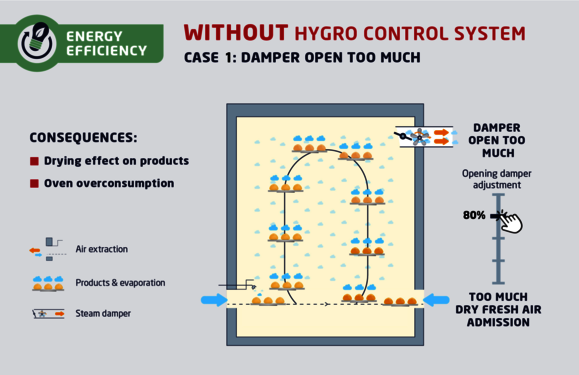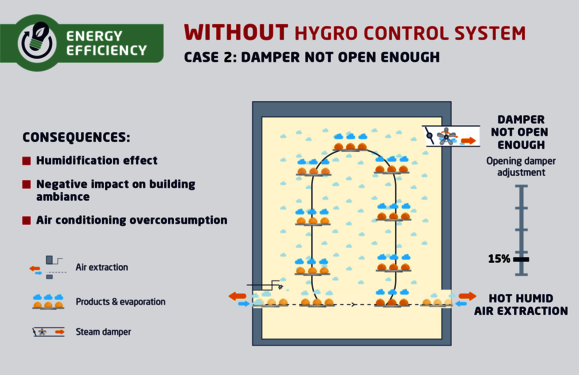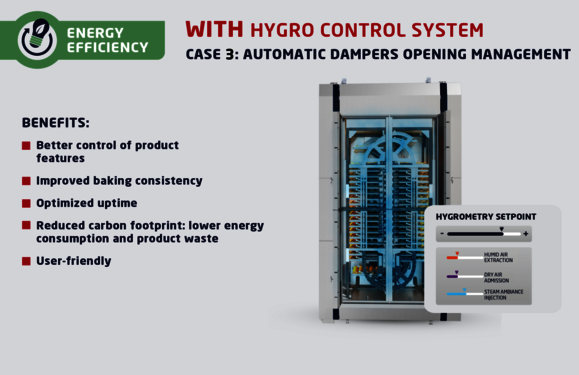Control hygrometry and optimize energy efficiency
Manufacturers in the bakery-pastry industry are constantly faced with a number of challenges, including the quest for product quality, optimal industrial performance, and sustainability. MECATHERM opens new horizons for the industrial sector thanks to innovations that favor sustainability, with a particular focus on energy transition.
In this sixth article, discover the importance of controlled hygrometry for optimal energy efficiency and a reduction in baking waste.
1. Understanding the importance of hygrometry management
Hygrometry in the baking chamber is a key parameter that has a significant impact on certain product characteristics such as crust thickness, water loss, and product softness.
This hygrometry level is the result of the quantity of steam injected into the oven, the quantity of steam generated by the products evaporation, the quantity of outside air entering the oven, and the quantity of humid air extracted by the dampers.
Today, the hygrometry in industrial ovens is managed empirically by the baker, by adjusting the damper’s opening. The baker doesn’t adjust steam injection by ramps to manage hygrometry because this parameter is linked to the desire to condense steam on the products.
2. There are two common scenarios with empirical management:
a) Damper is open too much
To dry out the oven environment, the baker can increase the opening of the dampers, which will accentuate the extraction of humid air. When the dampers are too open, too much air goes out of the baking chamber. This creates a slight depression in the chamber, drawing in air through the oven's inlet and outlet. As the outside air entering the baking chamber is colder than the baking temperature, it is heated, resulting in excessive energy consumption.

b) Damper is not open enough
To humidify the oven environment, the baker reduces the opening of the humid air extraction dampers. If dampers are not open enough, hot humid air will escape through the oven's inlet and outlet, which will have a negative impact on the building ambiance and generate overconsumption of the surrounding building's air-conditioning.
Let us also remember that it is difficult to maintain a stable hygrometry rate during production, even with a well-adjusted oven, because it also depends on external conditions linked to the climate.

3. Our solution: hygrometry management with “Hygro Control System”
MECATHERM has developed a turnkey solution, the Hygro Control System, to control the entering and outgoing flows into the oven, while guaranteeing product quality meets customer expectations. This solution reaches the minimum amount of humid air needed to extract and control the fresh air admission which is necessary to bake, reducing waste (non-conforming products) during transient conditions. The system automatically controls hygrometry to ensure regular baking and optimal energy efficiency. Manufacturers will benefit from energy savings related to steam and heating (gas or electric).
This innovation is made up of actuators for precise management of incoming and outgoing flows, providing real-time information on the state of the oven, and all connected with our smart software to adjust and guarantee a stable hygrometry during production. This system enables bakers to automatically achieve the desired hygrometry setting, while at the same time having greater control over product characteristics (water loss, softness, crust thickness, etc.). This is thanks to the precise control of hygrometry in the baking chamber, which is set up independently for each heating zone, the Hygro Control System simplifies the daily work for bakers.

MECATHERM offers its customers many possibilities to optimize their energy consumption and become key players in energy transition.
Want to learn more? Tell us about your baking challenges!
Interested in this topic? Read our articles about optimal energy efficiency.



